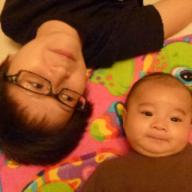✔ 最佳答案
動詞有兩種:連綴動詞及動作動詞。很明顯動作動詞就是表示主詞「在做甚麼」。如 hit (擊),kiss (吻)。致於連綴動詞就是表示主詞「是甚麼」。be 就是最常用的連綴動詞,而 be 因為主詞的第幾身作出變化如 am,is,are (現在式):
只有 I 才可用 am。
e.g. I am a boy.
He, She, It 都用 is
e.g. It is a dog.
You, We, They 用 are
e.g. They are students.
以上 be 都是作主要動詞。
be 亦可作輔助動詞:
為表示動作是進行一段時間的用進行式。前面一個be字再加-ing於主要動詞。這裡 be 的角式並非連綴動詞,它只輔助形成進行式來。
e.g. I am taking a shower right now. / She is walking the dog.
be 在主要動詞前,而主要動詞變作過去分詞時,那就成被動語態。
e.g. I am bitten by the dog. / The dog is hit by a car.
(*為什麼 the dog 用 is?如果用代名詞代替 the dog,我們會用 it。同樣地,I and Mary are in the same class. I and Mary 用代名詞代替,我們會用 we,所以用 are。)
Do 作主要動詞時是動作動詞,解「做」或「幹」。 現在式有 do,does。過去式只有did。
凡 He, She, It 後的動作動詞(現在式)都會加-s,do 也是。但一般情況,以 o 作尾加 es ,所以 do 變成 does 。
e.g. I do the dishes tonight. / She does her homework quickly. / Andy does his mathematics homework. (再參考*) / Yesterday, my brother did the dishes.
Do,does 亦可作輔助動詞,輔助動作動詞構成否定句或問句。
e.g. She dances. / She does not dance. / Does she dance?
I swim. / I do not swim. / Do I swim?
They ran away. / They did not run away. / Did they run away? (did作輔助動詞時,主要用原形動詞。所以之前用 ran,而後兩句用 run。)


